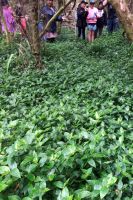Manuka Primary School, Auckland
Visited 17th October 2018
Monique Russell (our Auckland educator from the Tread Lightly Caravan) again joined Murray Dawson and Hugh Gourlay (Manaaki Whenua – Landcare Research) for the first of our two Auckland school visits during the week.
Manuka Primary School is a multi-cultural Decile 6 school located in Glenfield on Auckland’s North Shore. All 26 Y5–6 students were very engaged and a joy to work with. Karen De Silva was our host teacher at the school.
We started our morning introductions by collecting a sprig of mānuka (Leptospermum scoparium) – the school’s namesake – from the school grounds and sharing knowledge about this plant.
The students recognised it and knew that it was a native species. We then discussed that soon after European settlers arrived in New Zealand, they considered mānuka a major weed of pastures. Mānuka was one of the few native plants that interfered with grazing of livestock by competing with grasslands following fire clearance. We also explained that mānuka honey was once considered a low value product compared to clover honey, and how radically that view has changed in recent times. This was a good way of introducing perceptions and values of plants, and that a weed by definition is a plant growing where it is not wanted.
Monique skillfully led the class through our morning activities, which included Manaaki Whenua – Landcare Research videos teaching about biocontrol.
Murray then taught how to identify weeds and Hugh discussed biocontrol. Students were able to study seeds through microscopes to figure out how they disperse. The students also closely examined and handled green thistle beetles (Cassida rubiginosa) and tradescantia leaf beetles nicknamed ‘Shiny’ (Neolema ogloblini) to learn more about biocontrol.
There were several native bush reserves nearby to choose from for our afternoon fieldwork. Spinella and the adjacent Bonito Reserves were a short walk away and proved to be interesting places to look for, record, and collect weeds.
What were some of the plants that we found?
There was abundant tradescantia dominating the understory of Bonito Reserve. We explained to the class that this thick carpet was unfortunately suppressing growth of native seedlings. This was an ideal location for Hugh to release the tradescantia leaf beetles that he brought with him.
Ivy (Hedera helix) and tuber ladder fern (Nephrolepis cordifolia) were very common in this area, as weeds and as original plantings.
Weedy cotoneaster seems to be present in all of the areas we visit throughout New Zealand, and Glenfield was no exception.
We found a patch of onion weed (Allium triquetrum) in Spinella Reserve, which is always a firm favourite that students enjoy tasting! We explained that many weeds are poisonous and you should never eat anything that you are unsure of.
Other Environmental Weeds we found in the reserves included:
- calla lily (Zantedeschia ‘Green Goddess’)
- inkweed (Phytolacca octandra)
- Kahili ginger (Hedychium gardnerianum)
- Krauss’s clubmoss (Selaginella kraussiana)
- monkey apple (Syzygium smithii)
- red cestrum (Cestrum fasciculatum)
- Sods balsam (Impatiens sodenii).
Woolly nightshade (Solanum mauritianum) is also an Environmental Weed, and a major pest plant in Auckland. We found a relatively large tree (10 m or more tall) of this species, just over the road from the reserves.
In total we recorded 129 observations of 50 species.
Some of the observations we made were added to a local community project called Kaipatiki Creek and its Neighbours, and we had interesting discussion with that group about our weedy finds.

Manuka Primary School. Photo: Murray Dawson

Monique Russell with Manuka School students. Photo: Murray Dawson

Manuka School students designing their 'dream gardens'. Photo: Hugh Gourlay

Manuka School students designing their 'dream gardens'. Photo: Hugh Gourlay

Monique Russell with Manuka School students. Photo: Murray Dawson

Murray Dawson with Manuka School students. Photo: Hugh Gourlay

Murray Dawson discussing the weed arum lily with Manuka School students. Photo: Monique Russell

Manuka School student examining seeds under the microscope. Photo: Murray Dawson

Monique Russell showing a video on biological control. Photo: Murray Dawson

Murray Dawson teaching about weed identification. Photo: Hugh Gourlay

Hugh Gourlay helping students use smartphone apps to identify weeds. Photo: Monique Russell

Manuka School students handling green thistle beetles (Cassida rubiginosa). Photo: Monique Russell

Manuka School student handling a green thistle beetle. Photo: Monique Russell

Manuka School student handling a green thistle beetle. Photo: Monique Russell

Manuka School students recording tuber ladder fern on the way to the field site. Photo: Hugh Gourlay

Manuka School students collecting and recording weeds at Spinella Reserve. Photo: Hugh Gourlay

Manuka School students collecting and recording weeds at Spinella Reserve. Photo: Hugh Gourlay

Manuka School students collecting and recording weeds at Spinella Reserve. Photo: Hugh Gourlay

Murray Dawson talking about weeds to Manuka School students at Spinella Reserve. Photo: Hugh Gourlay

Manuka School students collecting and recording Sod's balsam at Spinella Reserve. Photo: Monique Russell

Manuka School students learning about the tradescantia dominating the understory of Bonito Reserve. Photo by students of Manuka Primary School

Sign at the entrance of Bonito Reserve, showing community appreciation of the site. Photo by students of Manuka Primary School

Manuka School students returning from the field trip. Photo by students of Manuka Primary School

Murray Dawson and Hugh Gourlay standing next to the Tread Lightly Caravan. Photo: Monique Russell

